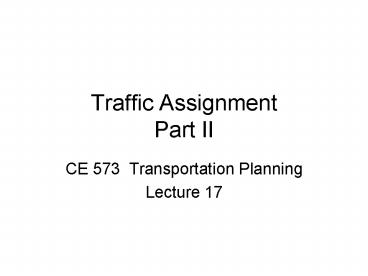Traffic Assignment Part II PowerPoint PPT Presentation
1 / 16
Title: Traffic Assignment Part II
1
Traffic Assignment Part II
- CE 573 Transportation Planning
- Lecture 17
2
Objectives
- Understand user equilibrium
- Execute a link cost update
- Communicate capacity restrained traffic
assignment concept - Execute incremental assignment
3
User Equilibrium Principles
- Principle A Under equilibrium conditions
traffic arranges itself in congested networks in
such a way that no individual trip maker can
reduce his path costs by switching routes. - Principle B Under equilibrium conditions
traffic arranges itself in congested networks
such that all used routes between an O-D pair
have equal and minimum costs while all unused
routes have greater or equal costs (to the used
path costs).
4
User Equilibrium Mathematical Form
5
Updating Link Costs
- Traffic assignment assign trips to links
- Gives volume on links
- Input link volumes into link cost functions
- Update link costs
6
Updating Link Costs (Example)
- Using equations of this form for link cost for
each link (travel time) - Where
- ta link travel cost per unit distance on link a,
- toa free flow travel time per unit distance on
link a, - Va flow on link a,
- Qpa practical capacity of link a, and
- a and ß calibration parameters for link cost
(a1.0 and ß3). - Given the volume estimated from All-Or-Nothing
(AON) assignment (last class example) - Update the link costs
7
Updating Link Costs (Example)
Links Links Links Links Links Links Links
Link 1-2 2-3 1-4 2-4 2-5 3-5 4-5
Link Volume 2700 1000 0 3100 0 1400 2100
Directional Volume (50/50) 1350 500 0 1550 0 700 1050
to 5 10 15 9 16 12 6
a 1 1 1 1 1 1 1
ß 3 3 3 3 3 3 3
Qp 1000 1000 1000 1000 1000 1000 1000
t (updated link cost) 17.3 11.3 15.0 42.5 16.0 16.1 12.9
8
Update P-Matrix and Compare to Previous Matrix
- Which links are, and are not, used?
- If you were to assign traffic with the updated
trees, would it be the same as it was before? - Which traffic assignment is correct?
- Should you combine the two traffic assignments
(before and after the update)? If so then how?
9
Capacity Restrained Traffic Assignment Algorithms
- Incremental Assignment
- Method of Successive Averages
- Frank-Wolfe Algorithm
10
General Traffic Assignment Approach
- n n 1
- Get previous solution (tan and Van-1)
- Update minimum cost path trees
- Do AON to get Fan?link volumes given previous
link costs - Search direction (Fan - Van-1)
- Step size (F)
- Update link volumes (Van)
- Update link costs (tan)
11
Incremental Assignment Concept
- The trip matrix T is assigned in proportions.
- Properties of the proportions z
- Each proportion 0 zn 1
- All proportions
- After a proportion of T is assigned to the
network - link volumes are updated
- link costs are updated
- Assignment is complete when all proportions (1
through N) are assigned
12
Incremental Assignment Algorithm
- Initialization of network database
- 1) get set of link costs (most likely freeflow)
- 2) set all link volumes to 0,
- 3) select set of proportions
- 4) begin at first proportions(n 0).
- Set n n 1
- Update the minimum cost trees
- All-or-nothing assignment (Fan)
- Update the link flows?Van Van-1 f Fan, where
f zn. - Update link costs (tan) based on Van and go to
step 2.
13
Incremental Assignment Application
- Proportions Say there are two
- z1 0.6
- z2 0.4
- Use previous example network
- See Excel file Incremental Assignment
Example.xls - What differences do you see between the AON file
and the Incremental file? - Why did these differences occur?
- Did we reach equilibrium?
14
Method of Successive Averages Concept
- Find previous solution
- Find current AON solution
- Establish a search direction
- Establish a step size 1/(number of iterations)
- Calculate the current solution
15
Method of Successive Averages Algorithm
- Initialization of network database
- 1) get set of link costs (most likely freeflow)
- 2) set all link volumes to 0,
- 3) set iteration number (n 0).
- Set n n 1
- Update the minimum cost trees
- All-or-nothing assignment (Fan)
- Update the link flows?, where f 1/n
- Update link costs (tan) given Van.
- Check for convergence if no convergence then go
to step 2.
16
Method of Successive Averages Application
- Use previous example network
- See Excel file MSA Assignment Example.xls
- What differences do you see between the AON file
and the MSA file? - Why did these differences occur?
- Did you reach equilibrium?

